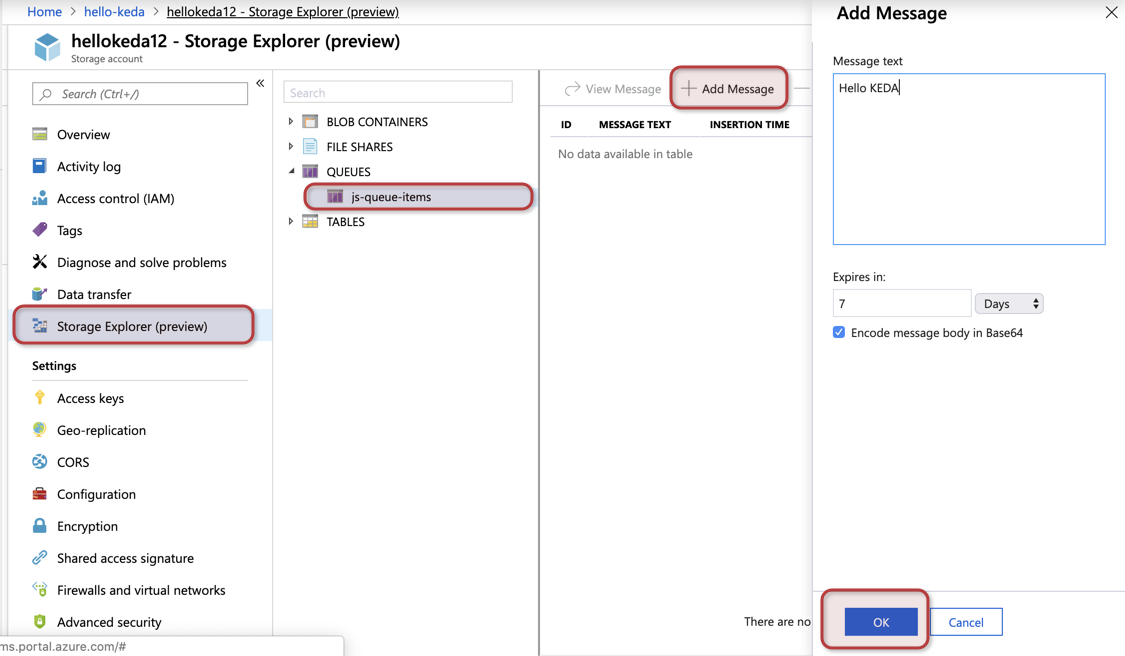This sample goes through the basics of creating an Azure Function that triggers on a new Azure Storage Queue message. The function can then be deployed to Kubernetes with KEDA for event driven activation and scale.
- Azure Function Core Tools v3. Makes sure the version is greater than: 3.0.3216
- An Azure Subscription (to host the storage queue). A free account works great - https://azure.com/free
- Kubernetes cluster (can be AKS, GKE, EKS, OpenShift etc.) and
kubectlpointing to your Kubernetes cluster (for AKS). NOTE: If you want to use KEDA with Azure Virtual Nodes, be sure to enable Virtual Nodes at create. - Docker and a Docker registry
mkdir hello-keda
cd hello-keda
func init . --docker
Select node and JavaScript
func new
Select Azure Queue Storage Trigger
Leave the default of QueueTrigger for the name
We'll create a storage account and a queue named js-queue-items
You can use the Azure CLI, the Azure cloud shell, or the Azure portal. The following is how you do it using Azure CLI.
<storage-name> would be replaced by a unique storage account name.
az group create -l westus -n hello-keda
az storage account create --sku Standard_LRS --location westus -g hello-keda -n <storage-name>
CONNECTION_STRING=$(az storage account show-connection-string --name <storage-name> --query connectionString)
az storage queue create -n js-queue-items --connection-string $CONNECTION_STRING
Open the hello-keda directory in an editor. We'll need to update the connection string info for the queue trigger, and make sure the queue trigger capabilities are installed.
Copy the current storage account connection string (HINT: don't include the ")
az storage account show-connection-string --name <storage-name> --query connectionString
Open local.settings.json which has the local debug connection string settings. Replace the {AzureWebJobsStorage} with the connection string value:
local.settings.json
{
"IsEncrypted": false,
"Values": {
"FUNCTIONS_WORKER_RUNTIME": "node",
"AzureWebJobsStorage": "DefaultEndpointsProtocol=https;EndpointSuffix=core.windows.net;AccountName=mystorageaccount;AccountKey=shhhh==="
}
}Finally, open the QueueTrigger/function.json file and set the connection setting value to AzureWebJobsStorage. This tells the function to pull the connection string from the AzureWebJobsStorage key we set above.
function.json
{
"bindings": [
{
"name": "myQueueItem",
"type": "queueTrigger",
"direction": "in",
"queueName": "js-queue-items",
"connection": "AzureWebJobsStorage"
}
]
}Replace the host.json content with the following. This pulls in the extensions to the function runtime like Azure Storage Queues support.
host.json
{
"version": "2.0",
"extensionBundle": {
"id": "Microsoft.Azure.Functions.ExtensionBundle",
"version": "[1.*, 2.0.0)"
}
}Start the function locally
func start
Go to your Azure Storage account in the Azure Portal and open the Storage Explorer. Select the js-queue-items queue and add a message to send to the function.
You should see your function running locally fired correctly immediately
[5/1/19 6:00:53 AM] Executing 'Functions.QueueTrigger' (Reason='New queue message detected on 'js-queue-items'.', Id=2beeca56-4c7a-4af9-b15a-86d896d55a92)
[5/1/19 6:00:53 AM] Trigger Details: MessageId: 60c80a55-e941-4f78-bb93-a1ef006c3dc5, DequeueCount: 1, InsertionTime: 5/1/19 6:00:53 AM +00:00
[5/1/19 6:00:53 AM] JavaScript queue trigger function processed work item Hello KEDA
[5/1/19 6:00:53 AM] Executed 'Functions.QueueTrigger' (Succeeded, Id=2beeca56-4c7a-4af9-b15a-86d896d55a92)
Follow the instructions to deploy KEDA in your cluster.
To confirm that KEDA has successfully installed you can run the following command and should see the following CRD.
kubectl get customresourcedefinition
NAME AGE
scaledobjects.keda.sh 2h
scaledjobs.keda.sh 2h
You can then deploy your function to Kubernetes. If you want to deploy so that the function may run on Virtual Nodes, follow 9b
First log in to docker from the command line with your user Id and password
docker login
Make sure you have created a private repo in docker.io to which your container image will be pushed.
func kubernetes deploy --name hello-keda --registry <docker-user-id>
This will build the docker container, push it to the specified registry, and deploy it to Kubernetes. You can see the actual generated deployment with the --dry-run flag.
To deploy your function Kubernetes with Azure Virtual Nodes, you need to modify the details of the deployment to allow the selection of virtual nodes.
Generate a deployment yaml for the function.
func kubernetes deploy --name hello-keda --registry <docker-user-id> --javascript --dry-run > deploy.yaml
Open and modify the created deploy.yaml to tolerate scheduling onto any nodes, including virtual.
spec:
containers:
- name: hello-keda
image: <your-docker-user-id>/hello-keda
env:
- name: AzureFunctionsJobHost__functions__0
value: QueueTrigger
envFrom:
- secretRef:
name: hello-keda
tolerations:
- operator: ExistsBuild and deploy the container image, and apply the deployment to your cluster.
docker build -t <your-docker-user-id>/hello-keda .
docker push <your-docker-user-id>/hello-keda
kubectl apply -f deploy.yaml
Initially after deploy and with an empty queue you should see 0 pods.
kubectl get deploy
Add a queue message to the queue (using the Storage Explorer shown in step 7 above). KEDA will detect the event and add a pod. By default the polling interval set is 30 seconds on the ScaledObject resource, so it may take up to 30 seconds for the queue message to be detected and activate your function. This can be adjusted on the ScaledObject resource.
kubectl get pods -w
The queue message will be consumed. You can validate the message was consumed by using kubectl logs on the activated pod. New queue messages will be consumed and if enough queue messages are added the function will autoscale. After all messages are consumed and the cooldown period has elapsed (default 300 seconds), the last pod should scale back down to zero.
kubectl delete deploy hello-keda
kubectl delete ScaledObject hello-keda
kubectl delete Secret hello-keda
az storage account delete --name <storage-name>
func kubernetes remove --namespace keda
